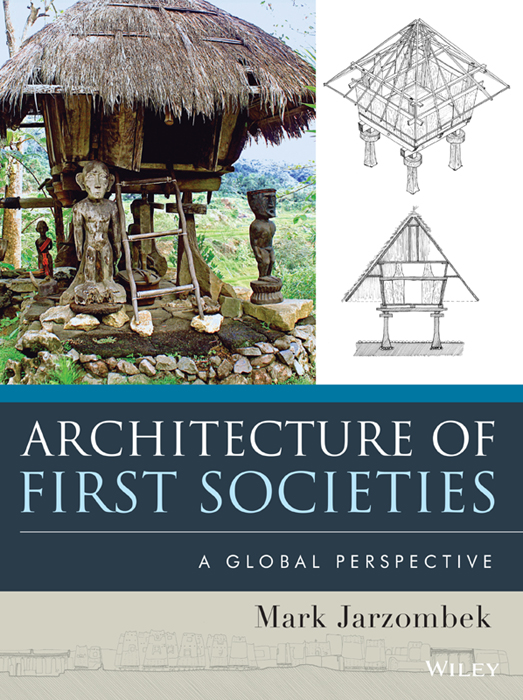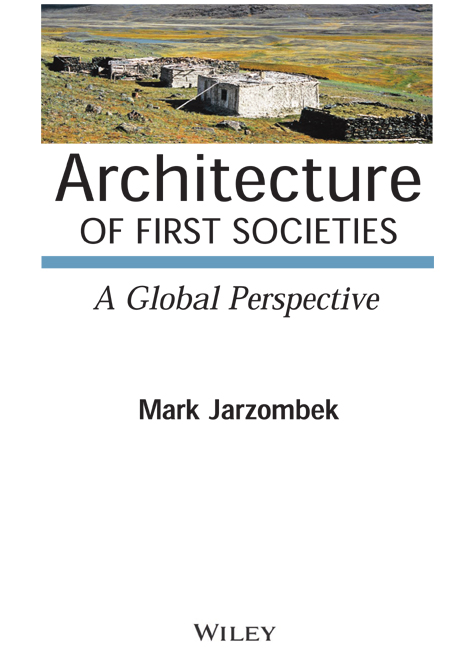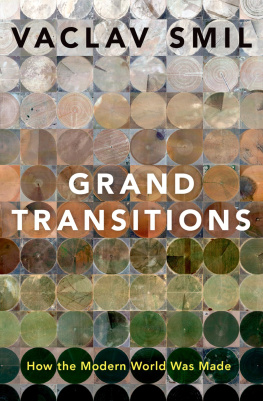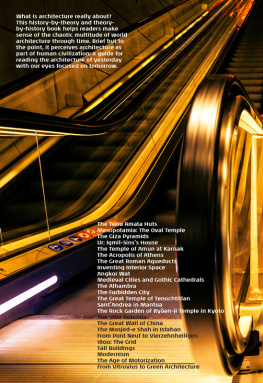Jarzombek - Architecture of first societies: a global perspective
Here you can read online Jarzombek - Architecture of first societies: a global perspective full text of the book (entire story) in english for free. Download pdf and epub, get meaning, cover and reviews about this ebook. City: Hoboken;N.J, year: 2013;2014, publisher: John Wiley & Sons, genre: Religion. Description of the work, (preface) as well as reviews are available. Best literature library LitArk.com created for fans of good reading and offers a wide selection of genres:
Romance novel
Science fiction
Adventure
Detective
Science
History
Home and family
Prose
Art
Politics
Computer
Non-fiction
Religion
Business
Children
Humor
Choose a favorite category and find really read worthwhile books. Enjoy immersion in the world of imagination, feel the emotions of the characters or learn something new for yourself, make an fascinating discovery.

Architecture of first societies: a global perspective: summary, description and annotation
We offer to read an annotation, description, summary or preface (depends on what the author of the book "Architecture of first societies: a global perspective" wrote himself). If you haven't found the necessary information about the book — write in the comments, we will try to find it.
Jarzombek: author's other books
Who wrote Architecture of first societies: a global perspective? Find out the surname, the name of the author of the book and a list of all author's works by series.
Architecture of first societies: a global perspective — read online for free the complete book (whole text) full work
Below is the text of the book, divided by pages. System saving the place of the last page read, allows you to conveniently read the book "Architecture of first societies: a global perspective" online for free, without having to search again every time where you left off. Put a bookmark, and you can go to the page where you finished reading at any time.
Font size:
Interval:
Bookmark:

Architecture
OF FIRST SOCIETIES

Copyright 2013 by John Wiley & Sons, Inc. All rights reserved.
Published by John Wiley & Sons, Inc., Hoboken, New Jersey.
Published simultaneously in Canada.
No part of this publication may be reproduced, stored in a retrieval system, or transmitted in any form or by any means, electronic, mechanical, photocopying, recording, scanning, or otherwise, except as permitted under Section 107 or 108 of the 1976 United States Copyright Act, without either the prior written permission of the Publisher, or authorization through payment of the appropriate per-copy fee to the Copyright Clearance Center, 222 Rosewood Drive, Danvers, MA 01923, (978) 750-8400, fax (978) 646-8600, or on the web at www.copyright.com . Requests to the Publisher for permission should be addressed to the Permissions Department, John Wiley & Sons, Inc., 111 River Street, Hoboken, NJ 07030, (201) 748-6011, fax (201) 748-6008, or online at www.wiley.com/go/permissions .
Limit of Liability/Disclaimer of Warranty: While the publisher and author have used their best efforts in preparing this book, they make no representations or warranties with the respect to the accuracy or completeness of the contents of this book and specifically disclaim any implied warranties of merchantability or fitness for a particular purpose. No warranty may be created or extended by sales representatives or written sales materials. The advice and strategies contained herein may not be suitable for your situation. You should consult with a professional where appropriate. Neither the publisher nor the author shall be liable for damages arising herefrom.
For general information about our other products and services, please contact our Customer Care Department within the United States at (800) 762-2974, outside the United States at (317) 572-3993 or fax (317) 572-4002.
Wiley publishes in a variety of print and electronic formats and by print-on-demand. Some material included with standard print versions of this book may not be included in e-books or in print-on-demand. If this book refers to media such as a CD or DVD that is not included in the version you purchased, you may download this material at http://booksupport.wiley.com . For more information about Wiley products, visit www.wiley.com .
Library of Congress Cataloging-in-Publication Data
Jarzombek, Mark.
Architecture of first societies: a global perspective / Mark Jarzombek.
pages cm
Includes index.
ISBN 978-1-118-14210-3 (cloth); 978-111-8-41921-2 (ebk.); 978-111-8-42105-5 (ebk.)
1. Architecture, PrehistoricTextbooks. I. Title.
GN799.B8J39 2013
722dc23
2012039442
Acknowledgments
Six years ago, I was preparing a lecture on the architecture of pre-history and discovered that the existing texts were either too generic or were written for experts. Plans, maps, and drawings were difficult to find, difficult to interpret, or altogether unavailable. Archaeological sites were disembodied spots on a map. And so what began as a desire to make a single lecture became a complex, multi-year project. As it developed and the more I learned, I ran various seminars to broaden the discussion with my colleagues here at MIT as well as with archaeologists, anthropologists, and researchers in various parts of the world, all of which proved invaluable.
Students came on board to help with the drawings and maps. I would like to thank in particular Timothy Cooke, who not only made numerous drawings, but also served as the books drawings coordinator; Alexander Wood coordinated photo acquisition and managed the complex world of digital files; Nicholas Polansky and Anne Callahan worked on drawings as well as on digital formatting; Adam Fulton assisted with research; Florence Guiraud and Michael Kubo produced the wonderful maps. All of these individuals worked long hours and occasionally through the night to meet deadlines. Others who made drawings were Ella Peinovich, Andrew Ferentinos, Daniele Cappelletti, Sun Min May Hwang, Nadine Volicer, Sasa Zivkovic, Farshid Emami, Jonathan Crisman, Reem Abuzeid, Anna Falvello Tomas, and Nancy Jarzombek. I would also like to thank the people from around the world who contributed photos. Anne Deveau kept the production schedule and helped monitor the perpetual flow of books, letters, and emails in and out of my office. The ever-smiling librarians at Rotch Library here at MIT who provided valuable assistance but who are probably relieved that this project has come to an end. I would also like to thank the editors at John Wiley and Sons, who shared the vision of this book.
Introduction
In 1901, a certain Reverend W. J. V. Saville visited an island off the coast of New Guinea to convert the inhabitants to Christianity. The book that he wrote about his efforts opens with the following words; The first thing that strikes one upon entering a Mailu village is its orderly arrangement. The villages are built on one distinct and characteristic plan. Two rows of houses, running parallel to one another, take the curve, if any, of the high-water mark on the shore. He goes on to describe in great detail the feasts, ceremonies, and other activities that take place between the rows of houses. Saville never seems to notice a rather glaring paradox. The same people whom he calls savages and who use stone age tools in harvesting their yams and taro plants are not only accomplished builders, but have a highly prescribed social and ritualistic worldview as defined by the layout of their settlements. The paradox is easily resolved, as any contemporary anthropologist will tell us, if we remove from the discussion any comparison with the modern world. That allows us to recognize that the orderliness of the Mailu shore-line settlement is not an anomaly, but dates back to the ancient origins of mankind. Organization of space is an integral aspect of human society, as fundamental as language and fire. A hundred thousand years ago, it may not have manifested itself in the archaeological record with quite the clarity of a Mailu village, but it cannot be dismissed that when humans first began to develop social groupings, spatial coherence in one way or another also became an attribute. This book is an attempt to capture that history within the bounds of our archaeological and anthropological knowledge.
In doing this, I tried to avoid some of the standard terms that one might encounter in such a text. Take for example, the word hunter-gatherer. Though widely used, it gained currency only in the 1970s against the backdrop of the United Nations War on Hunger and thus impliesquite falsely and pejoratively, as many anthropologists are now fully awarethat these people are obsessed with food acquisition. Food is just as important to ancient societies as it is to us, but so too are all the other activities that make us human. They will socialize, make huts, dance, cook, weave, and even relax. The image conjured up by the word hunter-gatherers also does a disservice to the affluence that many of these societies once had. The huge and geometrically complex mound of Poverty Point Louisiana, made up of approximately 238,000 cubic meters of fill, may have been made by so-called hunter-gatherers, but hunting and gathering were certainly the least things on the minds of the people who built this astonishing edifice. The term First Society may also have some limitations, but at least it reminds us that we are always dealing with societies not with individuals. The expression is used in the book for the broad range of cultures that did not change or shift to agriculture. This resolute attachment to the natural world should not be seen as a failing on their part, for we have to remember that people lived without agriculture for over a million years. These people not only survived, they thrived; nor is the history of the First Society world quite over. A few First Society cultures remain, despite transformative onslaughts, as living reminders of our ancestry.
Font size:
Interval:
Bookmark:
Similar books «Architecture of first societies: a global perspective»
Look at similar books to Architecture of first societies: a global perspective. We have selected literature similar in name and meaning in the hope of providing readers with more options to find new, interesting, not yet read works.
Discussion, reviews of the book Architecture of first societies: a global perspective and just readers' own opinions. Leave your comments, write what you think about the work, its meaning or the main characters. Specify what exactly you liked and what you didn't like, and why you think so.











